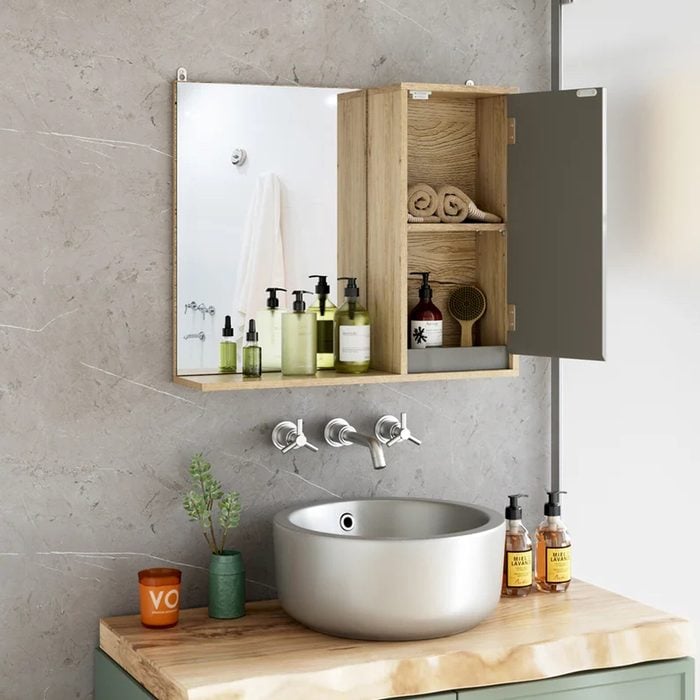A Complete Guide to Medicine Cabinets
Updated: May 07, 2024

Besides storing pills and vitamins, medicine cabinets hold lots of stuff that would otherwise clutter your sink or vanity top.
People in the 1800s would have scratched their heads if someone asked, “What is a medicine cabinet?” In those days, people visited physicians who stored medication, elixirs and herbs in their apothecary cabinets and mixed them as needed. It was rare that they stored enough of them in their own homes to warrant a dedicated cabinet.
It was only when medicines began to be mass-produced in the early 20th century that everyone needed their own apothecary cabinet at home. That became known as the medicine cabinet.
Every modern bathroom needs a little extra storage space, so a medicine cabinet has become a standard bathroom fixture. If you don’t have one or want to replace the one you have, you can find a medicine cabinet to fit any size bathroom. Installation is usually DIY friendly.
On This Page
What Is a Medicine Cabinet?
A medicine cabinet is a rectangular wall-mounted unit reserved for drugs, toiletries and other small items. It’s not the same as a bathroom cabinet, which holds towels and larger bathroom necessities. Medicine cabinets usually hang over the sink at eye level, high enough to prevent children from getting into it. Some lock for extra safety.
Medicine cabinets help eliminate clutter in the bathroom. A typical medicine cabinet is only four to seven inches deep, not enough for a hairdryer or a large bottle of shampoo. But perfectly sized to handle your medications, medical supplies, and other small items.
Because the placement offers full-frontal facial view, many also feature mirrors and even lighting. In this way, a medicine cabinet complements the bathroom vanity. It even may come with the vanity as part of a matching set.
Types of Medicine Cabinets
Medicine cabinets are typically from 20 to 22 inches high. Widths can vary from 15 inches to fit a single-basin vanity to 40 inches for a double-basin vanity. Two types are available:
- Recessed: A recessed medicine cabinet fits inside a hole cut into the drywall or plaster. It nestles snugly in the wall framing, leaving only the front trim and the door visible. Because the frame is hidden, it’s often made of plywood or medium density fiberboard (MDF). Recessing the medicine cabinet saves space in the bathroom. Storage is limited because it can’t be more than four inches deep, the combined width of the framing and the drywall.
- Surface-mounted: A surface-mount medicine cabinet hangs directly on the drywall or plaster. It has a decorative frame and can be deeper than a recessed one, although seven inches is a practical maximum.
Either type of medicine cabinet can be made of several materials, including:
- Wood: Manufacturers most commonly use oak. There’s no reason other species couldn’t be used, including your favorite exotic hardwood provided it’s finished with a moisture-resistant coating.
- Stainless steel: The sleek look of stainless steel goes well with monochromatic color schemes and minimalist bathroom design. Stainless steel maintains its shiny patina even in a humid bathroom environment.
- Aluminum: More lightweight than stainless steel but not as corrosion resistant, aluminum offers another option for people looking for the cleanliness of a metal surface.
- Molded plastic: There’s always a budget option. For medicine cabinets, that option is plastic. Good quality plastic units maintain their appearance for a long time, but inexpensive ones may turn yellow and brittle after a few years.
Buying a Medicine Cabinet
When shopping for a medicine cabinet, nothing’s more important than size. It should be the same width or narrower than the vanity, and fit between the backsplash and vanity lights with enough clearance so the door opens comfortably. Apart from that, consider these other important features:
- Mirror: Some have no mirror, others have one inset in the door frame, and still others are all mirror and no frame. The latter can double as a vanity mirror.
- Number of doors: Instead of a single door, some medicine cabinets have two or even three, each providing access to a section of the interior shelving. When there’s more than one door, they’re smaller and less likely to bonk anyone on the head when open.
- Shelving: Shelving is often adjustable, which adds flexibility to the storage capacity. Some medicine cabinets include exposed shelving attached underneath the door for easy access to items you use every day, like toothbrushes and vitamins.
- Hinges: You can mount hinges on the right- or left-hand side of the door. Standard swing is from 107 to 110 degrees, enough to clear the sink. Some hinges have a 170-degree swing, which allows the door to almost touch the back wall. This is a great perk for two people using the sink at the same time.
- Cost: Medicine cabinets aren’t as inexpensive as you might expect. You can find budget options for around $30, but some of the higher-end ones can run $1,000 or more. The average is around $200.
Installing a Medicine Cabinet
To install a surface-mount medicine cabinet, level it and drive screws through the back into the wall studs to hold it. Hanging a recessed cabinet where there was none before is more complicated, because it involves cutting out a section of drywall or plaster and installing framing. There may be pipes and wires in the way. If so, you may need to call an electrician and/or plumber to reroute them.
Medicine cabinet height
The height of the medicine cabinet depends on the height of the counter. In general, the top of the cabinet should be about 70 inches off the floor.
A nine-inch gap between the bottom of the cabinet and the backsplash leaves room for a GFCI outlet so you can plug in your hairdryer or shaver. Don’t forget that you need space between the top of the door and any overhanging vanity lights.
